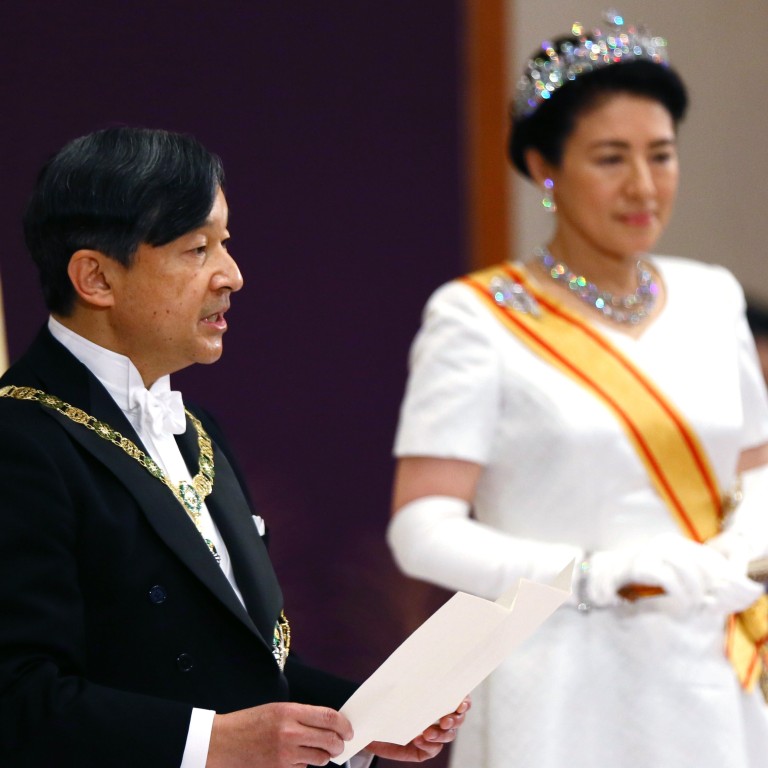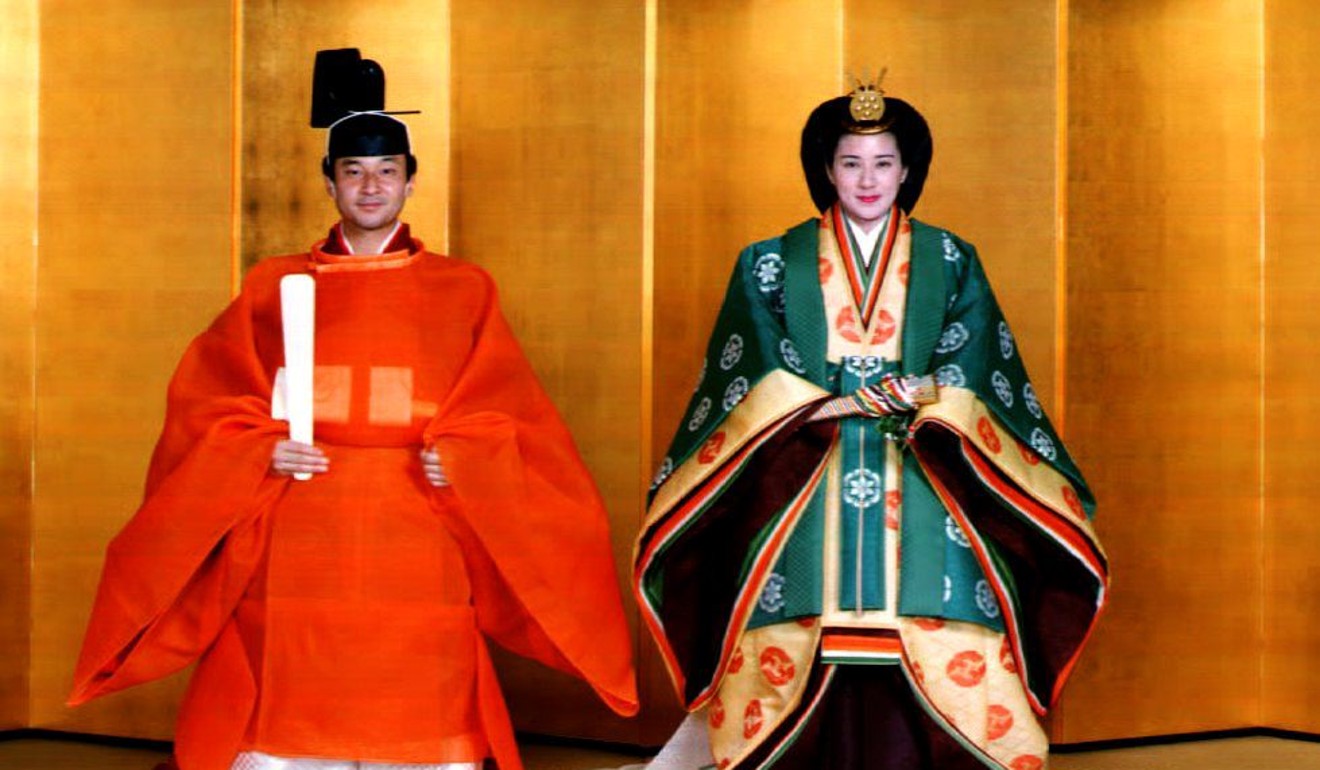
Japan has a new emperor and a new era – but can the royal family move past old, patriarchal traditions?
- Former emperor Akihito stood up to royal household a number of times over the years, and new Emperor Naruhito may bring about institutional change of his own
- Rules binding Japanese royal family don’t just mean they avoid celebrity status; they also make the likes of female succession a thorny issue
The Osaka company that came up with the idea to sell tinned air for 1,080 yen (US$10) a can thought it a suitable memento of the Hesei era of Emperor Akihito, 85, who abdicated after reigning for 30 years.
“I believe Naruhito has a strong desire to alter the imperial family in a number of ways, primarily by bringing it much closer to the public and making it more visible and accessible,” said Noriko Hama, a professor at Doshisha University in Kyoto.
“We have already seen his willingness to mix with ordinary people more freely – he has appeared in selfies with people on overseas visits. That was previously unheard of.”
SLOW TO CHANGE
Institutional change comes slowly in the traditional, rule-bound royal household, but former emperor Akihito is known to have held his ground a number of times over the years, and his son Naruhito may well draw on that to bring about institutional change of his own.

As crown prince in 1957, he met Michiko Shoda on a tennis court during a visit to the town of Karuizawa. The two quickly hit it off, although there was resistance to the budding romance from the Imperial Household Agency because of Michiko’s perceived lowly status, despite being the daughter of a wealthy industrialist.
He persisted, and they married in 1959. Conservatives and traditionalists were aghast that the prince had chosen his own bride, a commoner, instead of having one selected for him from among the daughters of former court nobility or one of the branches of the imperial family.
A sword, a jewel and a mirror: Japan’s Sacred Treasures explained
It has been reported that his own mother, the late Empress Kojun, opposed the union and drove Michiko into depression after the marriage by accusing her of not being a suitable match for her son.
The new emperor will want to change things in the imperial family
Makoto Watanabe, an associate professor of media and communications at Hokkaido Bunkyo University, said Naruhito appeared to have taken his own parents’ struggles on board in his determination to protect his family, and the public is supportive.
“The new emperor will want to change things in the imperial family, but he is in many ways fortunate because his own father has already brought about many changes and clearly had a difficult time doing that,” he said, referring to Akihito’s devotion to his wife and family.

“Marrying Michiko was a significant step on many levels, but after they were married, they insisted on raising their children themselves, rather than leaving that to the palace staff, because they wanted to be a normal family.
That might sound like a small issue, but it was a major change within the imperial household. They had to be brave to push for the things they wanted and they supported each other, and I believe Naruhito will take his cue from that.”
Mieko Nakabayashi, a former politician with the Democratic Party of Japan and now a professor at the school of social sciences at Waseda University, said: “He has said that he will protect his wife, his family, forever – and that is not an expression that the Imperial Household Agency would ever have heard before.
What to expect from Naruhito in the new Reiwa era
“The prince has been very well educated and prepared for his new role by both the emperor and empress. He is a patient person, he has a different perspective because he studied abroad, he is more modern in his outlook, he will make his own decisions.”
It is inevitable that this new generation of emperor and empress will have different ways of thinking
She also pointed out in choosing Masako for his wife, Naruhito chose a woman who studied at Harvard and Oxford, the daughter of a senior diplomat and someone who was on the fast-track at the Foreign Ministry herself before they married.
“It is inevitable that this new generation of emperor and empress will have different ways of thinking,” Nakabayashi said.
A QUESTION OF FEMALE SUCCESSION
Japan’s royal family has long been at the centre of much debate, thanks to conservative, patriarchal rules in place for centuries.
A key issue concerns the 1889 Imperial Household Law, which does not allow female succession. The new emperor and empress have only one child, a daughter, Princess Aiko. The current crown prince is Naruhito’s younger brother, Akishino, who helped settle the succession problem by having a son, Hisahito, now 12 and third in line to the throne.

“Interestingly, even conservatives seemed open to changing the law about women inheriting the throne back in 2006 when there was no male heir. But that changed after (Akishino) had a son,” said Marnie Anderson, a historian specialising in the social and political history of Japan at Smith College in the United States.
Who’s who in Japan’s imperial family
“The irony is that 19th-century Japanese officials borrowed these succession practices from their study of western monarchies. And the difference is that what was cutting-edge, indeed civilised, almost 130 years ago, appears outdated today,” she said.
Yumi Mizuno, a 29-year-old Tokyo office worker, said: “My view of the female royals is that they behave like icons and are very careful of what they say in public. It makes me feel sad when their titles changes from sama (esteemed Ms) to san (Ms) because they have to leave the royal family after marriage.”

‘NOT A REVOLUTIONARY FIGURE’
Others, however, think it may be too optimistic to expect change any time soon, because the royal household’s rules and traditions are too entrenched.
Naruhito may pose for selfies with ordinary people and want to make the imperial family more accessible, but observers agree there is no likelihood of the Japanese royals loosening up to the extent of resembling those in other countries, such as the British royal family.
Dignity and decorum remain the watchwords within the walls of the palace, and there will be no tabloid exposes of divorce, extramarital affairs or other humiliating details involving the private lives of Japan’s royal family.
It has been said that Japanese royalty work at being uninteresting, and will avoid the celebrity status of royals elsewhere.
Canadian journalist and royal watcher Saad Salman said: “The rigid rules and protocol of the imperial family, especially of females losing their imperial status after marriage, mean that there are few opportunities for them to develop the glamorous persona that make their European counterparts like Prince William, Kate Middleton or Prince Harry and Meghan Markle so popular and relevant.”
Any change during Naruhito’s reign would be gradual, said Waseda University’s Nakabayashi.
“He will not be a revolutionary figure; that is not what the imperial family wants nor what the Japanese people are looking for,” she said.
“He will not try to get involved in the nation’s political affairs, for example, but will want to be more accessible to the people. And that will be a continuation of the direction his own father took.”


